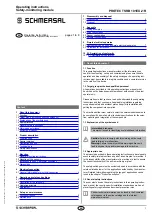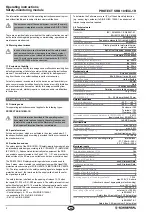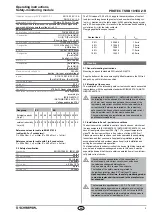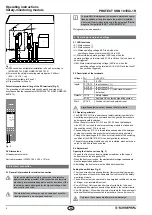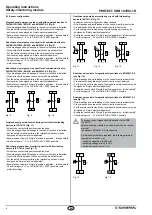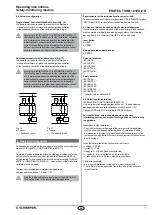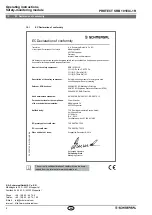
5
PROTECT SRB 101EXi-1R
Operating instructions
Safety-monitoring module
EN
U
EXi
U
B
U
i
K1
K2
SRB
101EXi
-1R
0V X1 X2
S11 S12 S21 S22
13 14 21 22
PA PA A1 A2
U
EXi
U
B
U
i
K1
K2
SRB
101EXi
-1R
0V X1 X2
S11 S12 S21 S22
13 14 21 22
PA PA A1 A2
S11 S12 S21 S22
PA PA A1 A2
nQS
QS
Fig. 3
Fig. 4
Fig. 5
6. Set-up and maintenance
6.1 Functional testing
The safety function of the safety-monitoring module must be tested.
The following conditions must be previously checked and met:
1. Correct fixing
2. Check the integrity of the cable entry and connections
3. Check the safety-monitoring module's enclosure for damage.
4. Check the electrical function of the connected sensors and their influ-
ence on the safety-monitoring module and the downstream actuators
6.2 Maintenance
A regular visual inspection and functional test, including the following
steps, is recommended:
1. Check the correct fixing of the safety-monitoring module
2. Check the cable for damages
3. Check electrical function
The device has to be integrated into the periodic check-ups
according to the Ordinance on Industrial Safety and Health/the
ATEX Directive (99/92/CE), however at least 1x/year.
Troubleshooting
No changes are allowed to devices, which are used in conjunction with
explosion-endangered areas.
Repairs to the devices are not authorised either.
Damaged or defective components must be replaced.
7. Disassembly and disposal
7.1 Disassembly
The safety-monitoring module must be disassembled in a de-energised
condition only.
Push up the bottom of the enclosure and hang out slightly tilted for-
wards.
7.2 Disposal
The safety-monitoring module must be disposed of in an appropriate
manner in accordance with the national prescriptions and legislations.
8. Appendix
8.1 Wiring examples
Dual-channel control, shown for a guard door monitor with two
position switches where one has a positive break contact; with
external reset button
J
(Fig. 6)
• Relay outputs: Suitable for 2-channel control, for increase in capacity
or number of contacts by means of contactors or relays with positive-
guided contacts.
• The control system recognises wire-breakage, earth faults and cross-
wire shorts in the monitoring circuit.
•
S
= Feedback circuit
0V
S12
J
S11
S21 S22
K
B
K
A
K
A
K
B
K
A
K
B
K2
K1
A2
PA
PA
N
14
22
d)
S
c)
b)
a)
K1
K2
U
i
U
EXi
F1
F2
U
B
13
L1
+24 VDC
21
A1
X1
X2
nQS
QS
Fig. 6
a) Installation in zone 1/21
b) Installation in zone 2
c) Logic
d) Control
8.2 Start configuration
External reset button (without edge detection) (see Fig. 7)
• The reset button is integrated in the feedback circuit in series as
shown.
• The safety-monitoring module is activated by the reset (after release)
of the reset button (= detection of the trailing edge). Faults in the reset
button, e.g. welded contacts or manipulations which could lead to an
inadvertent restart, are detected in this configuration and will result in
an inhibition of the operation.
• The reset button is controlled through an individual intrinsically safe
current circuit.
• To start the safety-monitoring module, the reset button may be desig
-
ned as "simple electrical apparatus".
• Examples see chapter 9 Simple "electrical apparatus – intrinsic safety"
X2
J
X1
K
A
K
B
Fig. 7

